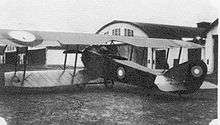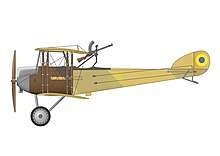Anatra
Anatra was an aircraft manufacturer founded by Artur Antonovich Anatra at Odessa, Ukraine, then Russian Empire in 1913 which manufactured several light aircraft designs from then to 1917.
The factory had been a naval workshop which was engaged in building foreign designs. They had constructed approximately twenty examples from 1909 through 1912. Anatra continued to build foreign designs by Farman, Morane, Nieuport, and Voisin at increasing rates, ultimately building at a rate of as many as sixty per month by 1917.[1] Later, the firm manufactured a few of its own designs for the Russian army during World War I.[2] Anatra was nationalised shortly after the Bolshevik revolution, and on 18 June 1918, the factory was destroyed by its former workers.
Aircraft


Foreign designs were the initial primary product of Anatra, with designs by the Farman Aviation Works, Morane-Saulnier, Nieuport, and Voisin. The later became the most significant, with the Voisin Type L forming the basis for an extensively redesigned Anatra V.I. design which flew in 1916. By this time, Anatra had already flown what would become the primary aircraft of its own design that would be produced by the company, the Anatra D, commonly called the Anade or Dekan in service as a reconnaissance aircraft with the Imperial Russian Air Force. This aircraft would go on to be further developed into the Anatra DS Anasal, another reconnaissance design destined for service in World War I.
In addition to the steady output of reconnaissance aircraft for Russia produced by the factory during the war, Anatra attempted development of a fighter design. One attempt, the Anatra Anadis was based on the Anasal, redesigned as a wooden semi-monocoque construction and equipped with a Hispano-Suiza engine. Ultimately, the single example was built as a two-seater, reportedly so that some of the company's French personnel could escape the deteriorating political situation in Russia. The aircraft was first flown on 23 October 1916, and on a later planned flight to Western Europe, the aircraft was lost in a force landing in Romania.[1]
An earlier attempt at a fighter design proved even less successful. The Anatra Anamon was a single-seat monoplane with a parasol wing and wooden monocoque fuselage. Armament was a single Vickers machine gun with deflecting plates on the propellers instead of an interrupter gear. This aircraft was widely criticized, and shortly after its initial flight on 16 June 1916, the single prototype crashed, ending the program.[1]
The only other significant design by Anatra was the Anatra DE, a three-engine bomber design.[2] The unique aircraft had two of the engines mounted in a pusher configuration and carried four crew members. Two of the crew manned gun turrets at the front of the engine nacelles. Bombload was planned to be 400 kg, but overall the aircraft was well overweight and ultimately the only prototype was damaged during its maiden flight on 23 June 1916.[1]
Vassili Nikolayevich Khioni, the company's lead designer, went on after the company's demise operating out of the factory and building several of his own designs. Many of these are often referred to as Anatra-VKh or Anatra-Khioni models.
| Model name | First flight | Number built | Type |
|---|---|---|---|
| Anatra D Anade | 19 December 1915 | 170 | Military reconnaissance |
| Anatra V.I. | 1916 | 139 | Military reconnaissance |
| Anatra Anamon | 16 June 1916 | 1 | Fighter |
| Anatra DE | 23 June 1916 | 1 | Bomber |
| Anatra DS Anasal | 25 July 1916 | 70+ | Military reconnaissance |
| Anatra Anadis | 23 October 1916 | 1 | Fighter |
References
| Wikimedia Commons has media related to Anatra aircraft. |
- Gunston, Bill (1995). The Osprey Encyclopedia of Russian Aircraft 1875-1995. Osprey. p. 1. ISBN 1 85532 405 9.
- Gunston, Bill (1993). World Encyclopedia of Aircraft Manufacturers. Annapolis: Naval Institute Press. pp. 24. ISBN 1-55750-939-5.